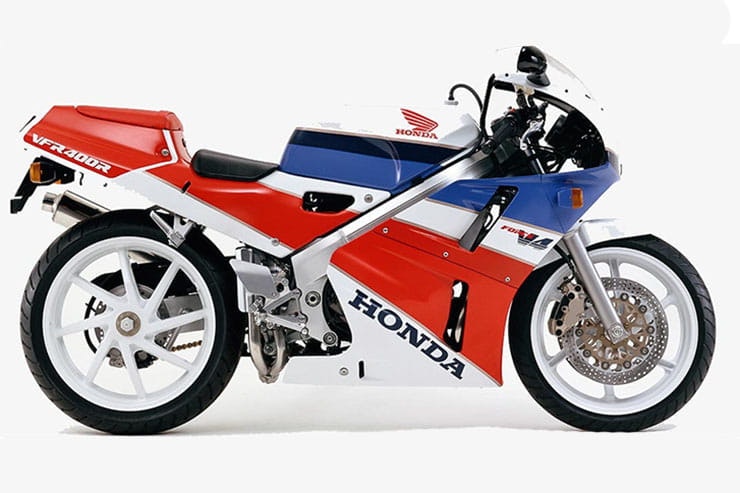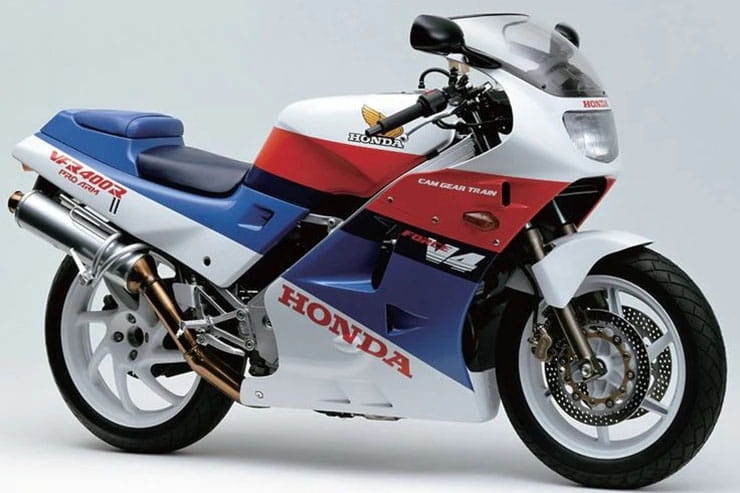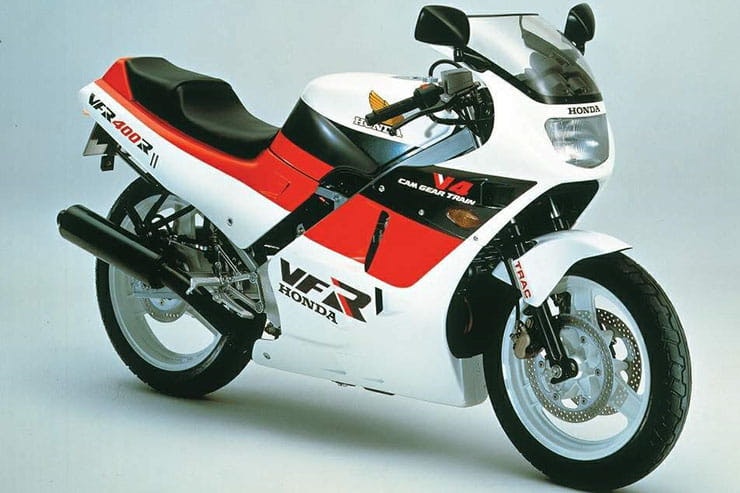Honda VFR400 (1986 - 1992): Review & Buying Guide
By Jim Moore
Bike journo for a quarter of a century
17.01.2024
Price: £3000-£9000 | Power: 59bhp | Weight: 165kg | Overall BikeSocial Rating: 4.5/5
Forget the fact that these Hondas are a mere 399cc in capacity. All three – NC21, NC24 and NC30 – are brilliant sports bikes in their own right. The latter is a perfect miniature replica of Honda’s legendary RC30, even boasting the same Pro-Arm rear end, endurance style clocks, gear-driven camshafts, close-ratio style gearbox, and 360° firing order (and therefore exhaust note) as its 750cc inspiration. So it’s little surprise then that the NC30 in particular is as desirable now as it was when launched in Japan back in 1989.
Most NCs on the UK used market are grey imports – overspill from a red-hot home market that consumed hundreds of thousands of the things – but there are also a few rare UK-spec 30s kicking about. When sold by Honda UK back in 1990-1991 these VFR400Rs cost more than a new CBR1000F, such was their exotic appeal and race shop build quality. Modern 400 twins can’t hold a candle to the NC’s finish, engineering, or performance, so the fact that they’re now over 30 years old matters not one jot. In fact, we may never see bikes of this capacity built to this standard ever again.
Of the three NCs, the 30’s still the one to go for, but the earlier incarnations – the 1986 NC21 and 1987 NC24 – are worth considering, especially if you’re on a budget. Both the 21 and 24 will nudge 130mph, offer predictable handling, decent ride quality and a level of reliability rarely bettered by their modern equivalents.
New riders love these little V4s because of their modest size and accessible performance, but so too do seasoned riders with a penchant for sporting prowess and an eye for classic style. With RC30 prices now nudging north of £30K, these gem-like miniatures are the next best thing – for less than a third of the price.
The NC is a mini RC30; what’s not to like
That stunning V4 engine that offers performance beyond its mere cee-cee
Superior engineering and build quality compared to modern 400s
NC21 and NC24 models’ skinny, old-school tyre sizes
Spares are getting harder to find
The NC is too small for many folk
Honda VFR400R (1986-1992) Price
The VFR400R was sold in three distinct forms – NC21, NC24 and NC30, with unfaired and market specific variants within those model types. For ease of identification, the 1986 NC21 was the first VFR400; essentially a pint-sized VFR750F in style and tech. The NC24 followed in ’87 – a sportier update of the 21 before the NC30 took over in 1989. Only the NC30 made it to the UK as an official import, albeit in small numbers – being full power (62bhp as opposed to 59) and rare they command a higher price on the used market than their grey import cousins, despite having less attractive detailing (big mirrors and winkers) than J-market machines.
1986 Honda VFR400R NC21 values: Rough £600-£1000; Tidy £1300-£2200; Mint £2700-£3200
Mini home-market version of the VFR750F, right down to the engine’s gear-driven cams. Aluminium perimeter chassis, sports touring ergonomics and styling, black 4-1 exhaust, 16-18in wheels. 59bhp, 163kg. An unfaired, twin-headlamp, 159kg version, the VFR400Z, was also sold in 1986-’87. Colours: white/red/black, black/white/red, red/white/blue HRC.
1987-’88 Honda VFR400R NC24 values: Rough £800-£1200; Tidy £1500-£2500; Mint £3000-£4000
Updated NC21, refreshed with a single-sided swingarm (Honda’s first on a production bike), new high-level exhaust, larger front discs, and 6/8-spoke wheels. 59bhp, 164kg. Colours: white/blue/red, Rothmans, red/white/blue HRC ’88.
1989 Honda VFR400R NC30:
Completely new model. A mini-RC30, right down to the V4 engine’s 360° firing order and distinctive flat drone. Aluminium beam frame, second gen Elf Pro-Arm rear end with single wheel nut, left-side exiting 4-1 pipe, 120/150 size tyres. 59bhp, 165kg. Colours: red/white/blue, black/silver/red/white Seed Racing
1990 Honda VFR400R NC30:
Various minor detail updates, including new indicators and a remote reservoir shock. New colours and graphics. First UK models imported – red/white/blue colour option only, as per 1989 Japanese model. UK feature larger indicators on longer stalks, a mph speedo, bigger mirrors, a numberplate light and a one-piece tail-light, as well as a non-speed restricted full power motor. Colours: white/blue/red, black/graphite/red, red/white/blue (UK)
1991 Honda VFR400R NC30:
Japanese ’91 model the same as 1990. An extra red colour option the only change. UK model’s red/white/blue colours/graphics now in line with home market bikes. Colours: white/blue/red, black/graphite/red, red/graphite/black
1992 Honda VFR400R NC30:
Black/graphite models dropped in favour of an HRC inspired colour option. No other changes. Colours: white/blue/red, red/graphite/black, white/red/black
NC30 values depend more on condition and originality, or country spec, than year of registration. Note that UK NCs command a higher value than imports, due to their rarity (import NC30s outnumber UK bikes by 20-1), original high price and full-power spec: see below.
J-market VFR400R NC30 values: Rough: £1200-£2000; Tidy £3000-£5000; Mint £6000-£8000
UK VFR400R NC30 values: Rough: £2500-£3000; Tidy £4000-£6000; Mint £7000-£9000
Honda VFR400R (1986-1992) Engine and Performance
Honda’s original V4 400, the VF400F, appeared in 1982. Although top end reliability issues plagued the firm’s larger V4s the 399cc unit proved to be a gem from the start, producing a claimed 53bhp and enough midrange punch to embarrass its inline-four rivals.
By the mid-1980s Japan’s 400cc market was booming so it was perhaps inevitable that technology from the VFR750F would filter down to its smaller siblings. The 1986 VFR400R NC21 was effectively a scaled-down 750F, right down its race-developed engine tech.
Honda did away with cam chains (the cause of many early V4 issues) in favour of gear-driven cams, a costly yet failsafe solution to cam chain rattle and tensioner failure. Basic engine architecture was the same as the VF400F – 55 x 42mm bore and stroke, 90° vee angle and 180° firing order, but compression was raised slightly from 11:1 to 11.3:1, a 4-1 exhaust replaced the VF’s old 4-2, and carb size was increased from 30mm to 34mm, resulting in a 6bhp stronger top end.
The next major development came with in 1989 with the NC30. Not only did the NC look every inch the mini RC30, it also had the 750R’s distinctive exhaust note thanks to a change in firing order – from 180° to 360°. The NC also got a scaled down copy of the RC’s left-side exiting 4-1 pipe and a close-ratio six-speed gearbox with a tall first gear (perfect for racing). Japanese market bikes made the same 59bhp as the 21 and 24, while ‘full-power’ export bikes produced a touch more at 62bhp. In favourable conditions an NC30 can kiss 140mph, and although the engine thrives on revs and doesn’t produce peak power until 12,500rpm, the unit’s spread of midrange torque is quite remarkable for such a modest capacity.
Honda VFR400R (1986-1992) Handling & Suspension
The NC21’s chassis is absolutely of its time: 16/18in three-spoke wheels connected by TRAC anti-dive equipped forks, an aluminium perimeter chassis and a single-shock rear end. In fact, the very same recipe as the first VFR750F – even the front sliding calipers are the same. In terms of ergonomics the NC21 is more sports tourer than pure sports, with relaxed clip-ons, lowish pegs. Only a modestly padded seat works against any mile-munching aspirations.
The 1987 NC24 looks quite different, with its high-mounted silencer, single-sided Pro-Arm rear end (Honda’s first use of the Elf tech on a road bike) and multi-spoke wheels, but it is in fact merely a tweaked 21. Slightly larger front discs improve braking a touch but the riding position, handling and feel of the ’87 machine match those of the NC21.
Things are radically different with the NC30. It enjoys a more compact and focussed riding position than the previous two VFRs, and is lighter too by 5kg, although the wheelbase is the same at 1345mm. Under-yoke mounted clip-ons give a racy feel, as does the ‘single’ seat, but the footpegs are lower set than you might imagine – it doesn’t require much effort to scrape them when cornering.
The 30’s frame is different too – a proper aluminium beam type married to an RC style Pro-Arm with single bolt fixing (the NC24’s a four-bolt arrangement). Forks are the same diameter as the 24’s, at 41mm, but without anti-dive intervention. Preload and rebound damping feature up front, the shock is fully adjustable.
NC30 handling is surprisingly stable. Cornering is aided more by the short wheelbase than radical steering geometry. Indeed the 30 feels a whole generation ahead of the 21/24 to ride. The only downside is its 18in rear wheel, but this can be swapped for a 17incher from an RVF400 (shorter linkage dog bones will help compensate for the inch difference in height).
Honda VFR400R (1986-1992) What to look for
Engine: A gem of a unit. Beautifully engineered and extremely reliable considering it makes peak power at 12,500rpm and revs onto 14,500rpm. Regular oil changes are key, however. Fresh lube (quality semi-synth) and filter every 3000 miles is a must. The engine’s miniature spark plugs aren’t cheap, at more than £60 per set. Valve clearances need inspecting every 16,000 miles.
Carbs: The positioning of any VFR’s carbs – between the vee – makes them susceptible to fuel settling and eventually hardening in the float bowls and jets, making starting and running problematic. A thorough clean is the only cure.
Spares: Getting thinner on the ground, especially quality OE bodywork (Tyga is an excellent alternative, particularly if you desire a more modern look). NC21 parts are the hardest to find, given their age and limited two-year run – some NC24 parts are interchangeable, however.
Aftermarket parts: They’re a mixed bag. Some stuff – such as Tyga bodywork/performance parts, Japanese exhausts, suspension upgrades etc – are worth having. Horrors such as coloured screens, mini carbon-look indicators, anodised bolts/footpegs devalue any modern classic, so are best avoided unless you can get the OE parts thrown in as part of the deal. Buying original parts separately can be an expensive business.
Restriction: Japanese market NC30s were speed restricted to 180kph (112mph) from new, but it’s easily bypassed by fitting either a MPH converter or removing the peg inside the speedo that triggers the ignition to cut-out at 180kph.
Tyres: All VFR400s run thoroughly unmodern tyre sizes. The 21 and 24s 16/18in combo is the most antiquated, with limited options. Pirelli’s Sport Demon and Bridgestone’s BT46 are perhaps the best options. The NC30’s 18-inch rear is its Achilles heel, with Bridgestone’s BT090 being the best bet for an OE sized pair. Avon’s Spirit ST is another option, but you’ll have to run a 160-section rear which will compromise both high speed stability and turn-in.
Speedo case: NC30 speedo cases get a hard time from the clutch cable adjuster, which rubs against it on full righthand lock. Almost all 30s suffer from this oversight. If the damage is extensive, you may consider buying a better nick speedo case.
Honda VFR400R (1986-1992) Rivals
Honda CBR400RR, 1990 | Approx Price: £3000-£6000
Power/Torque: 59bhp/28.2lb-ft | Weight: 165kg
Honda’s other exotic 400, the inline-four CBR400RR Gull-Arm is a match for the VFR400R NC30 in pretty much every respect. Stylish, exotic, exquisitely engineered, and a riot to ride, the Gull-Arm is also slightly more spacious than the VFR, so suits larger riders far better than the V4. A low seat height means it’s a hit with short riders too.
Kawasaki ZXR400L, 1990 | Approx Price: £2500-£4500
Power/Torque: 62bhp/26lb-ft | Weight: 160kg
Another 400cc race replica imported into the UK (from 1990 as the L model – previous H model is a grey import only, as are both SP models). Gorgeous styling, sweet steering, but harsh damping, particularly at the rear, spoils the ride. Engine lacks the character of the VFR’s. The large pool of used examples is helpful, however.
Yamaha FZR400RR, 1992 | Approx Price: £2000-£4000 (up to £7000 for SP)
Power/Torque: 66bhp/28.9lb-ft | Weight: 162kg
The 400RR was officially imported to the UK in 1992. Claimed power (66bhp) is a touch higher than Japanese spec. Great handling, fun to ride – sharp chassis, strong motor with EXUP exhaust valve. SP version comes with close-ratio ’box, better suspension, and single seat; expect to pay more (up to £1000-£1500) for this model.
Honda VFR400R (1986-1992) Verdict
VFR400Rs are modestly sized machines that made a massive impact, both in Japan and here in the UK. Age hasn’t dimmed their appeal, especially that of the NC30. Some purists still prefer the VFR to its arguably better RVF400 replacement, mainly because of the RC30 connection, which is way more authentic than that of the NC35 to the RVF750 RC45. If you’re in the market for a classic 400, these VFRs – and Honda’s other offering, the CBR400RR – should be top of your list.
Honda VFR400R (1986-1992) - Technical Specification
Looking for motorcycle insurance? Get a quote for this motorbike with Bennetts bike insurance


